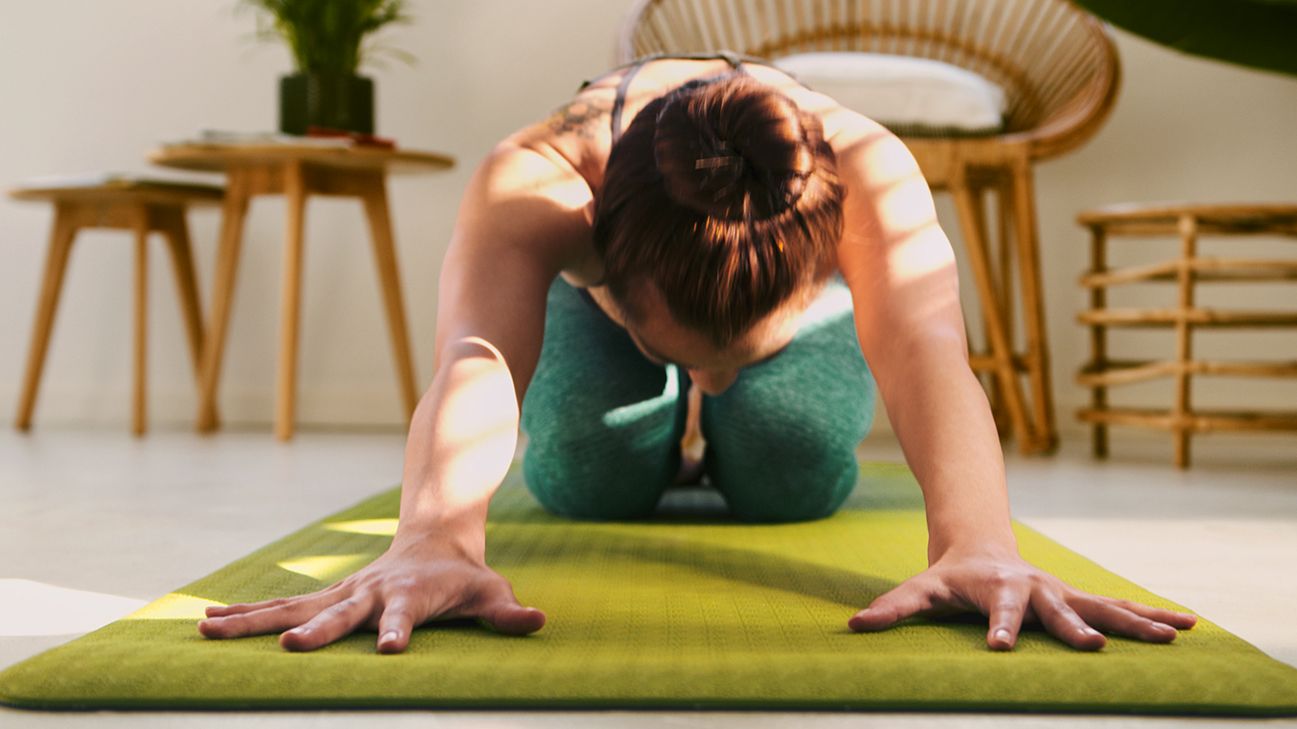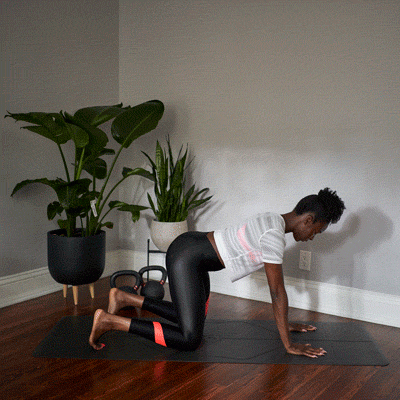Discover the benefits of the Child’s Pose stretch, ideal for beginners and seasoned yogis. This simple yoga posture may relieve tension, improve flexibility, and enhance mindful breathing. Learn how to master it.
Ready to breathe and stretch like your only worries are homework and Saturday morning cartoons? You’re in luck then! Child’s Pose (aka Child’s Resting Pose or Balasana) is ready and waiting to play a role in your yoga routine.
What is Child’s Pose? In brief
Child’s Pose is a super simple resting yoga pose that’s perfect for wedging between more difficult postures.
- Start in kneeling position. Touch your big toes together while sitting on your heels, keeping your knees in line with your hips.
- Bend forward while exhaling, finishing with your torso against your thighs, forehead to the floor.
- Keeping palms upward, relax your arms beside your body.
- Inhale and exhale for 30 seconds to a few minutes, coz’ it’s a resting pose.
Rest up, breathe easy, and still your mind ahead of the more demanding poses.
We run down where to slot Child’s Pose into your yoga routine, which muscles it benefits, and how to breathe when you’re getting your Balasana on.


Child’s Pose is mad popular in yoga. You’ve probably done it a bunch of times already if you’re a yoga enthusiast. Just getting into your yoga flow? Cool. Child’s Pose is a great place to start.
In yoga, even resting poses need good form to help you stretch out the right way. Here’s how to achieve it with Child’s Pose:
- Start in Table Pose (kneeling on the floor, with your knees and hips lined up, as well as your hands and shoulders).
- Keep your big toes touching, then sit on your heels. Your knees should be kept apart roughly in line with your hips.
- Exhale. Moving forward with your outward breath, lay your torso flat between your thighs. Tilt your lower back outward toward the floor. Stretch the rest of your back away from your pelvis and tilt your head forward.
- Lay your arms flat alongside your torso, with your palms facing upward. Relax your arms and shoulders, allowing the fronts of your shoulders to pull toward the floor. Their weight should stretch your shoulder blades across your back.
- Hold right there for 30 to 60 seconds, being sure to inhale and exhale deeply.
- When you’re exiting the pose, lengthen your front torso first. Then, doing a deep inhale as you go, lift your body back into Table Pose, slowly from your tailbone where it presses down into the pelvis.
Physical therapists prescribe Balasana pretty often as a stretch for folks with mobility issues. This is because it’s simple, relaxing, and great for improving mobility and relieving stiffness.
Breathing through Child’s Pose
Getting the most out of Child’s Pose means more than just perfect form. You’ll need to get your breathing down, too — great yoga form is the perfect union of breathing and movement. Tina Fey and Amy Poehler, but in your lungs.
Child’s Pose is super useful for developing awareness around your breathing. Because Child’s Pose keeps your chest pressed against your thighs, your belly can’t expand as much as usual. You’ve got to breathe around the ribs to get your full dose of O2.
This leads to slow, deliberate breaths — it’s a helpful way to center your attention on your breathing and regain control. Controlled breathing also brings down your heart rate. And if you’re getting your yoga on for relaxation purposes, that’s kind of the goal.
In Balasana, your breathing focus should be:
- your lower back rising on the inhale
- your lower back falling on the exhale
Every yoga posture you do will have its own set of tasty body benefits. Here’s why working Child’s Pose into your yoga routines is a pro-gamer move:
- It gently stretches out your spine, thighs, hips, and ankles.
- Because it’s a resting pose filled with deep breathing, it’s mega relaxing.
- Child’s Pose can stimulate blood flow to your head, and blood circulation helps oxygen reach all corners of your bod.
- Child’s Pose can relieve tension in the chest, lower back, shoulders, and hamstrings.
- As a super basic pose, it can support mobility outside of a full yoga sesh, too. If you’re at your WFH desk, feeling tight and achy, you can drop to the floor and bust out Child’s Pose for a minute to loosen up.
The science behind the stretches
Of course, Child’s Pose also comes with all the benefits of yoga, because it’s yoga, and yoga is good for you. Don’t just take our word for it though. Science has found loads of legit yoga benefits, including:
- Yoga is great for circulation. In fact, a 2017 study found that Child’s Pose specifically had a positive impact on blood pressure and heart rate. If you’re aiming for a yoga routine to help with cardiovascular problem, Balasana should definitely be involved.
- There’s been tons of research that proves yoga helps with pain management. One notable study, again from 2017, found that yoga could be an invaluable tool for helping peeps manage chronic pelvic pain. The researchers selected 12 yoga positions, including Child’s Pose.
- In 2020, a study identified Balasana as one of the many postures that’s great for targeting back and spine discomfort.
- A 2013 study found that regular yoga improved sleep quality in peeps receiving treatment for cancer. Child’s Pose was one of the positions included in the research.
It’s not just physical health, either. A 2017 review found that yoga practice has a net positive effect on mental health and well-being.
However, the experts here did take the time to point out that more regulation/research would be necessary before rolling out a bona fide yoga mental health treatment program. The results are very promising though, and more recent research continues to suggest that daily yoga practice is good for helping get you out of a slump.
Even though Child’s Pose is a basic yoga pose, there are ways to both ease into it for beginners and level it up for peeps in search of a little extra stretch.
You’ll start unlocking new advanced forms of standard poses as you level up in yoga. Child’s Pose is no different.
Use a yoga block
Yoga shouldn’t hurt. Peeps who are less flexible might have a tough time getting their head all the way to the mat.
If that sounds like you, bring the floor toward your head by resting your forehead on a yoga block or folded blanket. Once you feel flexible and comfortable enough, you can take the block out of the equation and stretch forward a little further.
Extended Child’s Pose
In this variation, slowly walk your hands out to the front edge of your mat rather than keeping them by your sides. This can help you add a little deep shoulder stretch to your Balasana.
- Enter Child’s Pose as usual. However, this time when you sit back on your heels, stretch your arms out in front of you, palms flat.
- Tilt your hips backward, toward the balls of your feet. Relax your upper body, allowing your chest, shoulders, and torso to sink toward the floor.
- Loosen your shoulders, letting them droop down away from your ears. Let any tension you’ve been carrying in your shoulders, neck, and upper back fall away with them.
- When you’re ready to come out of the pose, bring your arms in back toward your sides, then exit the position as if it were a normal, nonextended Balasana.
Child’s Pose with side stretch
Keeping with the “arms out in front” theme, you can follow up by throwing in a little side stretch to focus on your core and back:
- From Extended Child’s Pose, extend your left arm off to the left.
- Bring your right arm in the same direction, keeping your palms on the floor.
- Once your arms are in position, give your hips a gentle push to the right.
- Mirror the steps for the opposite side.
As yoga goes, Child’s Pose is pretty simple. That doesn’t mean you can expect to get it perfect on your first try though — yoga is an ever-evolving practice that grows with you. Here are some common errors in form and ways to adjust them.
Your butt doesn’t reach your heels
Try to sit your butt on your heels. This can be difficult, though, and it may take a bit of practice (especially if you’re stiff in the ol’ hips, calves, or lower back).
Child’s Pose should be relaxing, but some folks find it a bit uncomfortable. This could be because of knots or stiffness in your back. If that’s hella relatable, start on back-focused postures (like Cat-Cow Pose) first, then adopt Child’s Pose later in your yoga journey.
In yoga, there’s no right or wrong place to be. Make sure you’re not hurting or straining yourself.
Don’t ignore your neck
Your neck position is important — it’s best not to overlook that.
You can add a pillow or yoga block underneath your head (as seen in the variations above) to make sure your neck stays neutrally positioned and pressure-free.
Child’s Pose (aka Balasana) is a resting yoga pose. You enter it by kneeling on the floor, placing your chest into your thighs and forehead into the ground, then letting your arms go palms-up and floppy by your sides.
It’s a great position for entry-level yoga heads. You can also use it as a sturdy foundation for mindful breathing since it encourages slower breathing. It has a bunch of benefits, from tension relief to stretching your legs and back.
There are several Child’s Pose variations, and each can help you target a specific part of the body or relieve a different area of tension. Adding pillows or yoga blocks can help you ease into it.
By incorporating it into a regular yoga routine, this simple pose can help you recapture that child-like love of life.

